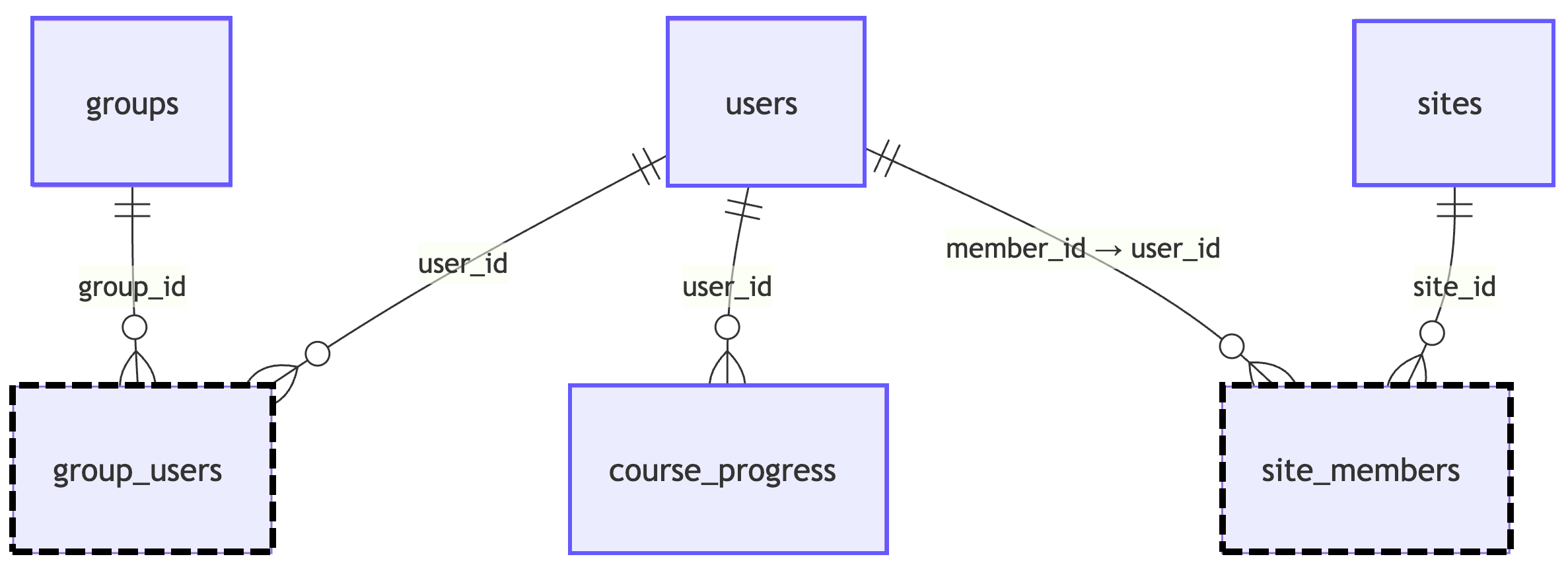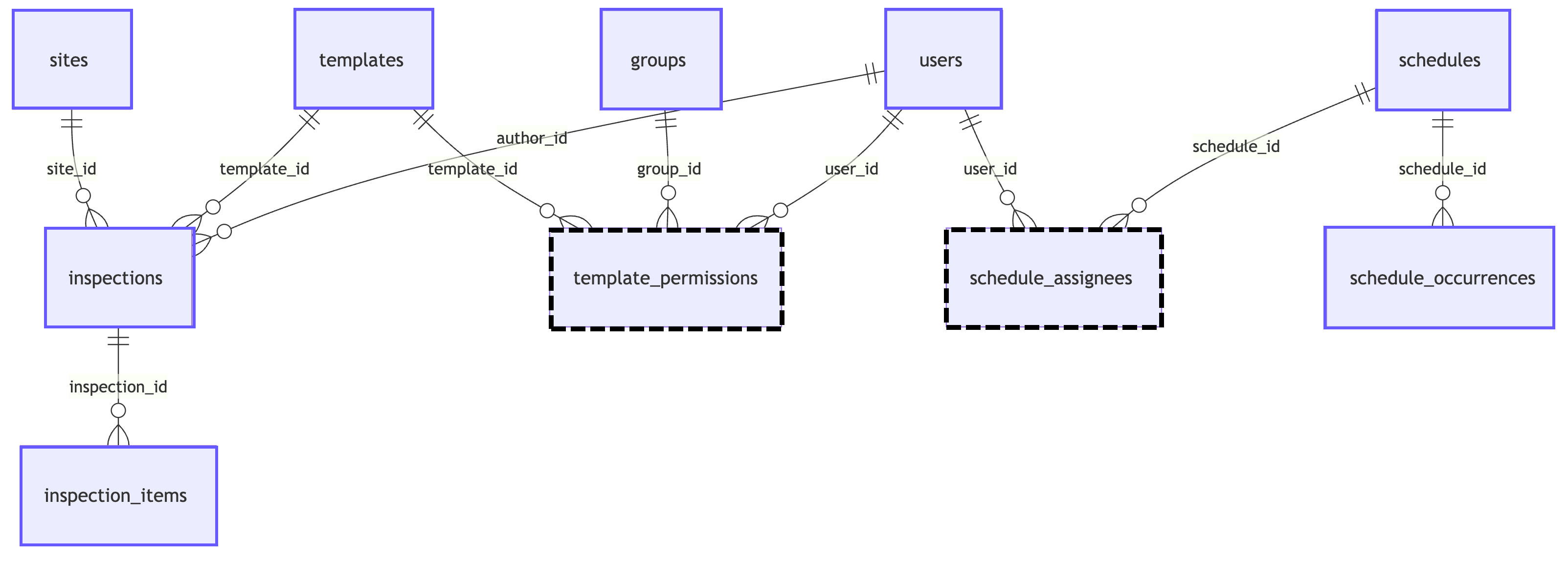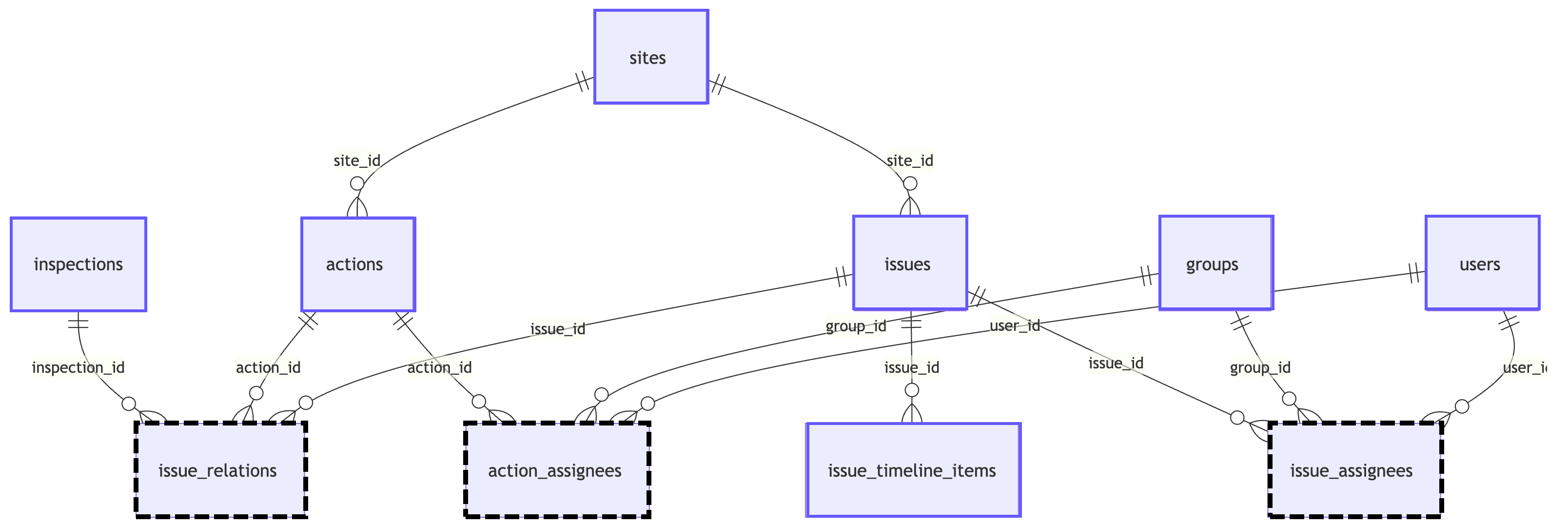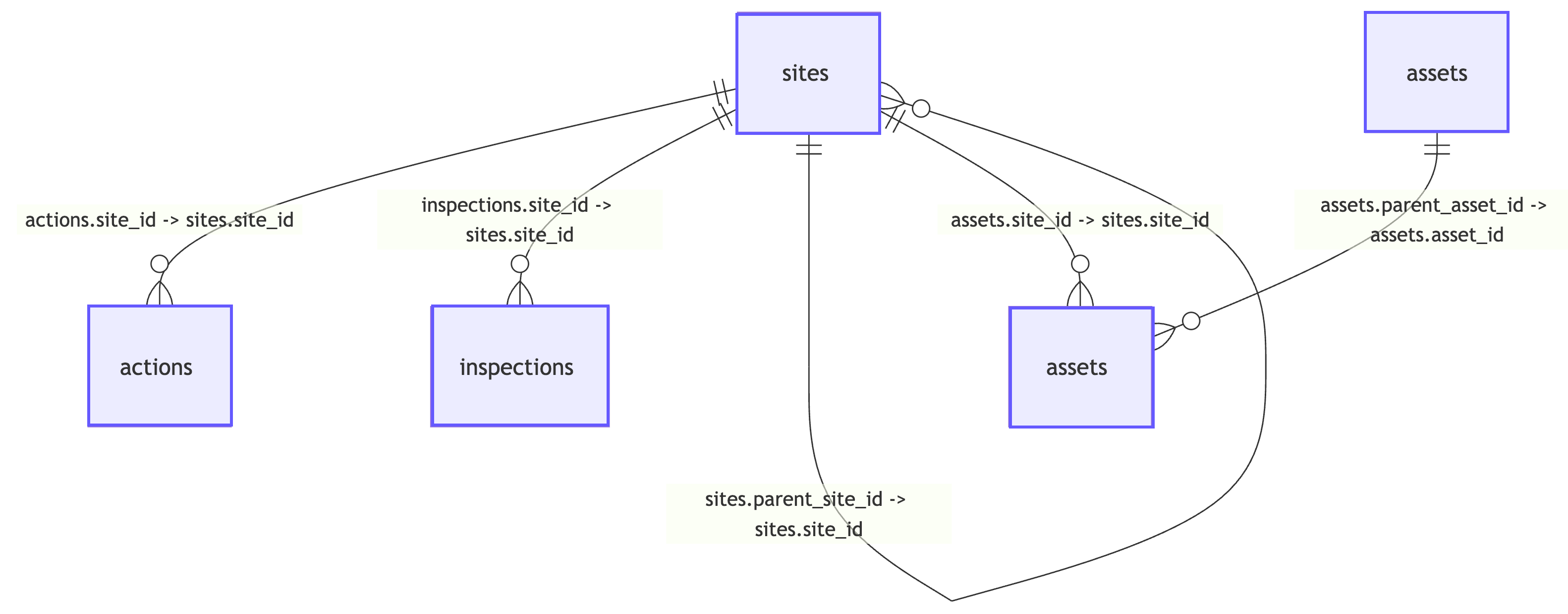Data relationships
Data model overview
This page is your map of SafetyCulture data across Exporter, the Power BI connector, and the Data Feeds APIs. It shows how datasets relate, which keys to join on, and where to start organized into four domains: People, Work, Tasks, and Structure.
How to use this page
- Start with a question. Example: “Who is a member of each site?”
- Open the relevant domain slice. For the example: People.
- Use the diagram + key join callouts to build your relationships.
Example joins:
site_members.member_id=users.user_id,site_members.site_id=sites.site_id.
Export and access methods
Use SafetyCulture Exporter for ad-hoc or scheduled bulk files, Power BI connector for direct dashboards, and Data Feeds APIs for programmatic, incremental pipelines. Review the decision guide for trade-offs.
All three access paths expose the same logical model and only the transport differs.
Domains
Domain slice | Go here for | Datasets | Primary bridges to other slices |
|---|---|---|---|
People([/data/people]) | Info about users, groups, memberships, or learning status. |
|
|
Work([/data/work]) | Define, plan, and analyze work (forms, schedules, inspections). |
|
|
Tasks([/data/tasks]) | Track actions/issues, ownership, and timelines. |
|
|
Structure([/data/structure]) | Work by location or asset. | sites (hierarchy), assets |
|
Data diagrams per domain
Legend
- Purple box = dataset (table/feed).
- Box with a dotted border = Link tables (many↔many bridges)
- Cardinality (crow’s-foot)
- ↣o (circle + crow’s-foot) = 0..* on that side (optional, many).
- | (single bar) = exactly one (1).
- || (double bar) = one and only one (mandatory 1).
- Join notation:
child_fk→parent_pk
People ↔ Structure model (Users, Groups, Site membership)
Use these datasets to relate users/groups to sites. The link tables are group_users and site_members (alias: site_members.member_id = users.user_id).

Entities
| Dataset | Primary key | Purpose |
|---|---|---|
users | user_id | People in your organization. |
groups | group_id | Cohorts for permissions/assignment. |
group_users | (group_id, user_id) | Link table: users ↔ groups |
sites | site_id | Locations (often hierarchical) |
site_members | (site_id, member_id) | Link table: users ↔ sites (member_id = users.user_id) |
course_progress | internal id or course_id + user_id | Per-user learning/enrollment/progress |
Join cheat sheet
| From (child) | To (parent) | ON (child_fk → parent_pk) | Notes |
|---|---|---|---|
group_users | users | user_id → user_id | — |
group_users | groups | group_id → group_id | — |
site_members | users | member_id → user_id | Alias |
site_members | sites | site_id → site_id | — |
course_progress | users | user_id → user_id | Roll up by site via users → site_members → sites |
Cross-slice pointers for orientation
- To Work: joins typically use
user_id(authors/owners/assignees) andsite_id(where inspections occur).- To Tasks : assignee tables reference
user_id/group_id; actions/issues may also carrysite_id.
Work data model (Templates, Inspections, Item responses, and Template access)
This diagram shows how work is defined and executed. Templates define the work; inspections are the runs of that work; item-level responses live in inspection items; and template permissions control who can use/manage each template. Cross-domain bridges are shown to Sites (where work happens) and Users/Groups (who can access or authored the work).

Entities
| Dataset | Primary key | Purpose |
|---|---|---|
templates | template_id | Definition of work (forms). |
inspections | inspection_id or audit_id | Executed runs of a template. |
inspection_items | (impl PK; joins via inspection key) | Item/question-level responses. |
template_permissions | (impl PK; joins via template_id, user_id/group_id) | Access/usage rights for templates. |
schedules | schedule_id | Planned work. |
schedules_assignees | Internal/opaque ID or composite (varies) | Per-user learning/enrollment/progress |
schedules_occurrences | Internal row ID (not required for joins) | Generated instances of planned work. |
sites | site_id | Location context (Structure slice). |
users | user_id | People context (People slice). |
groups | group_id | Cohorts (People slice). |
Join cheat sheet
| From (child) | To (parent) | ON (child_fk → parent_pk) | Notes |
|---|---|---|---|
inspection_items | inspections | inspection_id → inspection_id | Use canonical key (inspection_id or audit_id). |
inspections | templates | template_id → template_id | — |
inspections | sites | site_id → site_id | Cross-slice bridge to Structure. |
inspections | users | author_id → user_id (or owner_id → user_id) | Choose field name used in feeds. |
template_permissions | templates | template_id → template_id | Link table |
template_permissions | users | user_id → user_id | Link table |
template_permissions | groups | group_id → group_id | Link table |
schedule_assignees | schedules | schedule_id → schedule_id | Link table |
schedule_assignees | users | user_id → user_id | Link table |
schedule_assignees | groups | group_id → group_id | Link table |
schedule_occurrences | schedules | schedule_id → schedule_id | Link table |
Tasks (Actions, Issues, assignments, and relations)
Use these datasets to model task ownership and traceability across your environment. Actions and Issues live at sites, are assigned to Users/Groups via link tables, and Issues can relate back to Inspections and Actions for end-to-end traceability.

Entities
| Dataset | Primary key | Purpose |
|---|---|---|
actions | action_id | Remediation/next-step tasks; can be site-scoped. |
action_assignees | internal/composite | Assigns actions to users and/or groups. |
issues | Reported issues/incidents; can be site-scoped. | |
issues_assignees | internal/composite | Assigns issues to users and/or groups. |
issue_timeline_items | internal row id | Status/history events for an issue. |
issue_relations | internal/composite | Traceability links: issue ↔ inspection/action. |
inspections | inspection_id (or audit_id) | Referenced by issue_relations. |
sites | site_id | Location context for actions and issues. |
users | user_id | Actors/assignees. |
groups | group_id | Cohorts for assignment. |
Join cheat sheet
| From (child) | To (parent) | ON (child_fk → parent_pk) | Notes |
|---|---|---|---|
action_assignees | actions | action_id → action_id | Link table |
action_assignees | users | user_id → user_id | Link table |
action_assignees | groups | group_id → group_id | Link table |
actions | sites | site_id → site_id | Site context |
issue_assignees | issues | issue_id → id | Link table |
issue_assignees | users | user_id → user_id | Link table |
issue_assignees | groups | group_id → group_id | Link table |
issue_timeline_items | issues | issue_id → id | History of an issue |
issue_relations | issues | issue_id → id | Traceability root |
issue_relations | inspections | inspection_id → inspection_id (or audit_id) | Keep key label consistent with Work slice |
issue_relations | actions | action_id → action_id | Links issues to actions |
issues | sites | site_id → site_id | Site context |
Structure data model (Sites and Assets)
Use the Structure slice to answer “where” things happen and to roll up all other data by location. Sites form a hierarchy (such as Region → Facility → Area). Assets are equipment/objects that usually live at a site. Other slices (Work and Tasks) reference Sites via site_id.

Entries
Dataset | Primary key | Purpose |
|---|---|---|
|
| Location nodes in a hierarchy. Self-join on parent to model hierarchy. |
|
| Equipment/objects located at sites. Typically carries |
(bridges from other slices; not entities of this slice) | — | inspections, actions, and sometimes issues each carry site_id to link back to sites. |
Join cheat sheet
| From (child) | To (parent) | ON (child_fk → parent_pk) | Notes |
|---|---|---|---|
sites (child) | sites (parent) | parent_site_id → site_id | Models site hierarchy (root sites have NULL parent). |
assets | sites | site_id → site_id | Places assets at a site. |
inspections (Work) | sites | site_id → site_id | Some orgs allow inspections without a site; LEFT JOIN if nullable. |
actions (Tasks) | sites | site_id → site_id | Site context for actions. |
Updated 13 days ago